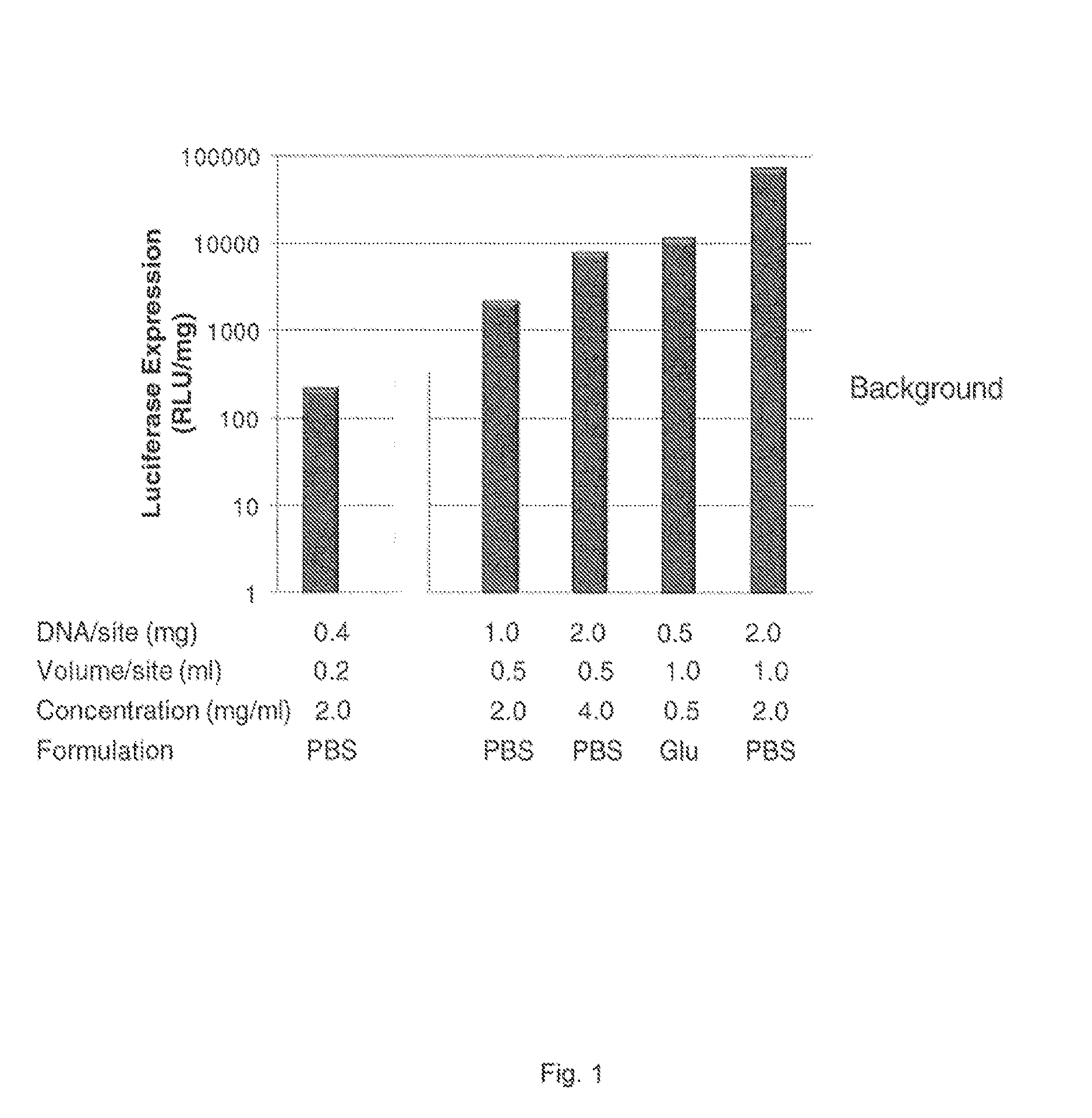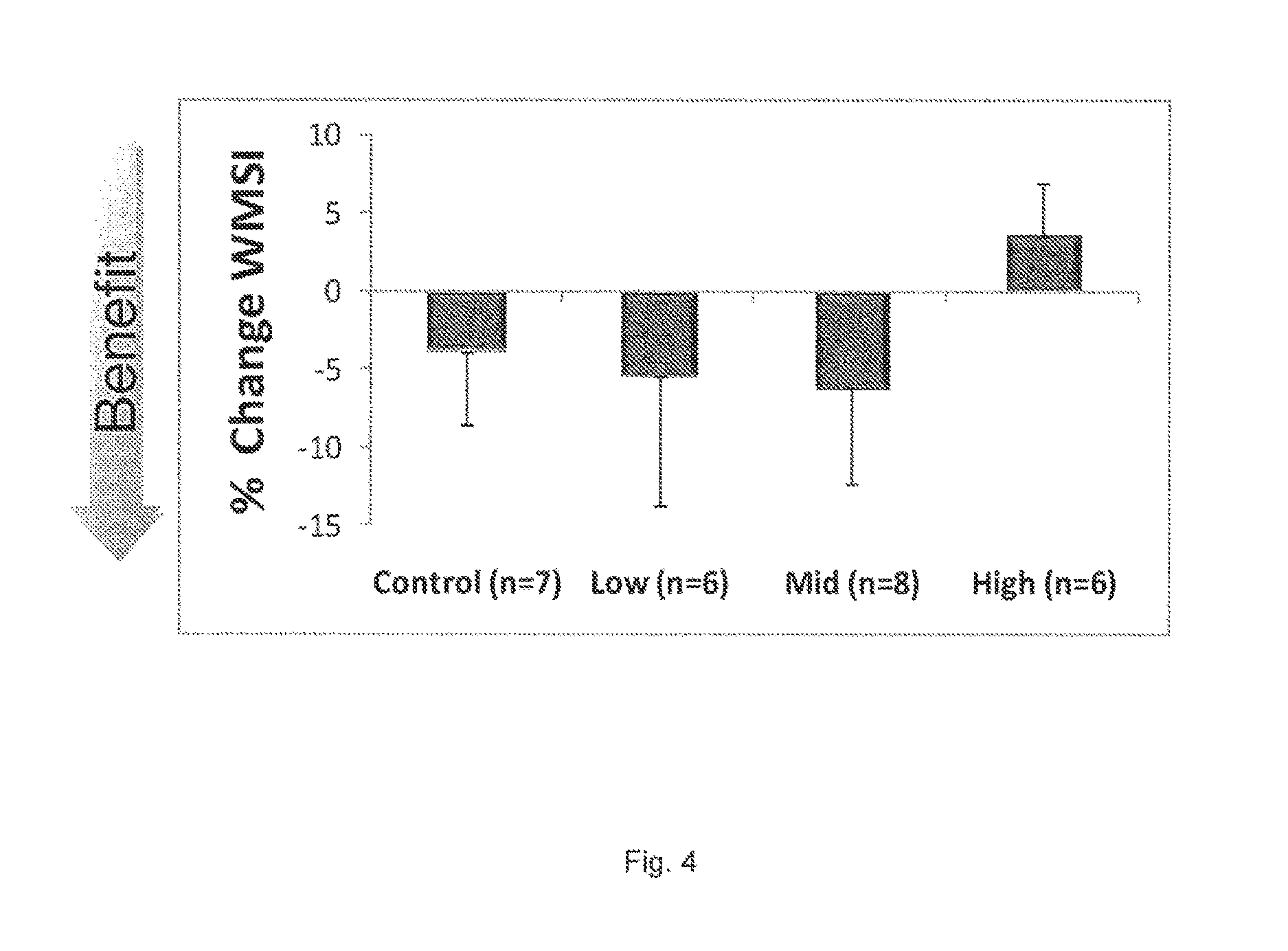SDF-1 delivery for treating advanced ischemic cardiomyopathy
a cardiomyopathy and advanced technology, applied in the direction of active genetic ingredients, peptide/protein ingredients, genetic material ingredients, etc., can solve the problems of reduced substrate supply and accumulation of metabolites, atrophy, denaturation, necrosis of affected tissues, and considerable proportion of patients with cli are not suitable for revascularization, so as to improve the ejection fraction of left ventricular cells, improve the systolic volume of left ventricular end, and improve the systolic volum
- Summary
- Abstract
- Description
- Claims
- Application Information
AI Technical Summary
Benefits of technology
Problems solved by technology
Method used
Image
Examples
example 1
[0220]Stromal cell-derived factor-1 or SDF-1 is a naturally-occurring chemokine whose expression is rapidly upregulated in response to tissue injury. SDF-1 induction stimulates a number of protective anti-inflammatory pathways, causes the down regulation of proinflammatory mediators (such as MMP-9 and IL-8), and can protect cells from apoptosis. Furthermore, SDF-1 is a strong chemoattractant of organ specific and bone marrow derived stem cells and progenitor cells to the site of tissue damage, which promotes tissue preservation and blood vessel development. Based on observations that increased expression of SDF-1 led to improved cardiac function in ischemic animal models, we focused on developing a non-viral, naked-DNA SDF-1-encoding plasmid for treatment of ischemic cardiovascular disease. During the course of development, the plasmid was optimized based on cell culture and small animal study results described below. The plasmid a plasmid having the nucleotide sequence of SEQ ID NO...
example 2
Expression of Plasmid in Porcine Myocardium
[0231]A porcine occlusion / reperfusion MI model of the left anterior descending artery (LAD) was selected as an appropriate large animal model to test the efficacy and safety of ACRX-100. In this model, 4 weeks recovery is given between MI and treatment to allow time for additional cardiac remodeling and to simulate chronic ischemic heart failure.
Surgical Procedure
[0232]Yorkshire pigs were anesthetized and heparinized to an activated clotting time (ACT) of ≧300 seconds, and positioned in dorsal recumbency. To determine the contour of the LV, left ventriculography was performed in both the Anterior-Posterior and Lateral views.
Delivery of Luciferase Plasmid into Porcine Myocardium
[0233]A deflectable guide catheter device was advanced to the left ventricle retrograde across the aortic valve, the guide wire was removed, and an LV endocardial needle injection catheter was entered through the guide catheter into the LV cavity. Luciferase plasmid w...
example 3
Improvement in Cardiac Function by SDF-1 Plasmid Treatment in Porcine Model of Ischemic Cardiomyopathy
Induction of Myocardial Infarction
[0237]Yorkshire pigs were anesthetized and heparinized to an activated clotting time (ACT) of ≧250 seconds, and positioned in dorsal recumbency. A balloon catheter was introduced by advancing it through a guide catheter to the LAD to below the first major bifurcation of the LAD. The balloon was then inflated to a pressure sufficient to ensure complete occlusion of the artery, and left inflated in the artery for 90-120 minutes. Complete balloon inflation and deflation was verified with fluoroscopy. The balloon was then removed, the incision was closed, and the animal was allowed to recover.
Enrollment Criteria
[0238]One month post-MI, cardiac function in each pig was assessed by echocardiography. If the LVEF was less than 40% and the LVESV was greater than 56.7 ml, the pig was enrolled in the study.
Surgical Procedure
[0239]Each enrolled pig was anesthet...
PUM
| Property | Measurement | Unit |
|---|---|---|
| end systolic volume | aaaaa | aaaaa |
| volume | aaaaa | aaaaa |
| concentration | aaaaa | aaaaa |
Abstract
Description
Claims
Application Information
 Login to View More
Login to View More - R&D
- Intellectual Property
- Life Sciences
- Materials
- Tech Scout
- Unparalleled Data Quality
- Higher Quality Content
- 60% Fewer Hallucinations
Browse by: Latest US Patents, China's latest patents, Technical Efficacy Thesaurus, Application Domain, Technology Topic, Popular Technical Reports.
© 2025 PatSnap. All rights reserved.Legal|Privacy policy|Modern Slavery Act Transparency Statement|Sitemap|About US| Contact US: help@patsnap.com



